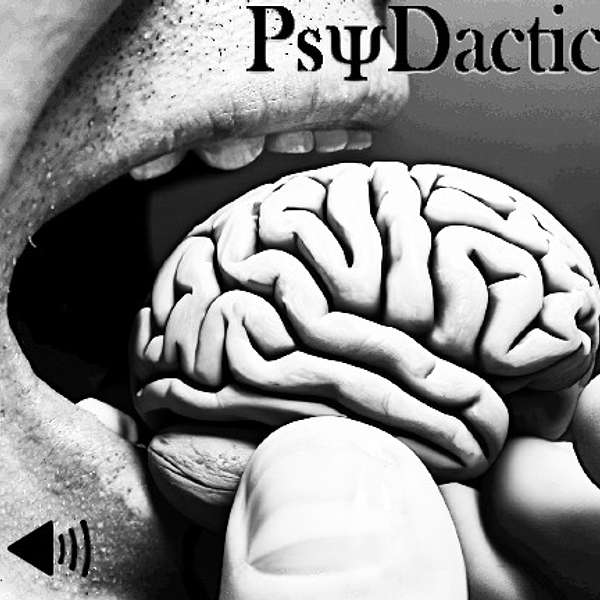
PsyDactic
A resource for psychiatrists and other medical or behavioral health professionals interested in exploring the neuroscientific basis of psychiatric disorders, psychopharmacology, neuromodulation, and other psychiatric interventions, as well as discussions of pseudoscience, Bayesian reasoning, ethics, the history of psychiatry, and human psychology in general.
This podcast is not medical advice. It strives to be science communication. Dr. O'Leary is a skeptical thinker who often questions what we think we know. He hopes to open more conversations about what we don't know we don't know.
Find transcripts with show-notes and references on each episodes dedicated page at psydactic.buzzsprout.com.
You can leave feedback at https://www.psydactic.com.
The visual companions, when available, can be found at https://youtube.com/@PsyDactic.
PsyDactic
Catatonic Signs - Catalepsy, Postering, Grimacing and Waxy Flexibility
In this episode, I discuss Catalepsy, Postering, Grimacing and Waxy Flexibility. I grouped the diagnostic signs that I am going to cover today because they are all similar. Your patient acts like a wax statue.
Please leave feedback at https://www.psydactic.com or send any comments to feedback@psydactic.com.
References and readings (when available) are posted at the end of each episode transcript, located at psydactic.buzzsprout.com. All opinions expressed in this podcast are exclusively those of the person speaking and should not be confused with the opinions of anyone else. We reserve the right to be wrong. Nothing in this podcast should be treated as individual medical advice.
Signs of Catatonia: Catalepsy, Postering, Grimacing and Waxy Flexibility
Welcome to PsyDactic Residency Edition. I am Dr. O and this episode is a continuation of our series on Signs of Catatonia. Today, I’ll discuss Catalepsy, Postering, Grimacing and Waxy Flexibility. I grouped the diagnostic signs that I am going to cover today because they are all similar. Your patient acts like a wax statue. If you are encountering this episode without listening to the whole series on Catatonia, I suggest that you back up to episode 11 and start from there.
Today, I am going to discuss how to identify the signs of catatonia that cause a patient to either hold a position against gravity or give a steady resistance to changing that position. They act like a wax statue from Madame Tussauds. This requires some level of involuntary muscle tone.
It is important to distinguish between being rigid and being statuesque. Someone who is rigid may be experiencing involuntary muscle tone due to Parkensonian symptoms or EPS. Torticollis for example, when a patient is turning their head to the left or the right due to involuntary contraction of the sternocleidomastoid, although it could be mistaken as actively holding part of the body against gravity, it is not a sign of catatonia. It is more likely a pathological side effect of dopamine antagonists. A rigid appearing pt may also be experiencing a seizure. Catatonia is different.
One of the frustrating things about catatonia is that many of its signs are basically rule-outs. Another frustrating thing is that the signs often seem to be very similar or even subsets of each other. For example, mutism is likely present in stupor, so is this basically counting stupor twice? But mutism can be present without stupor as well, so it seems like you shouldn’t count it in stupor. And what in tarnation is the difference between catalepsy, grimacing, and posturing? In my reading I have found nothing satisfying, but I did encounter some descriptions that might or might not be helpful.
Posturing can be defined as the patient putting themself into a position that is not accomplishing any task and holding that position for an oddly long period of time. It seems to require a level of awareness and at least a limited interaction with the world. This is in contrast to a stereotypy, when a patient is actually performing some pointless action repetitively or for a long period of time, while in posturing they are holding a pointless position in a way that seems to require effort. The defining characteristic of posturing then can be that the patient initiated the posture.
Catalepsy on the other hand can be diagnosed, for example, if the examiner puts the patient into a posture and they maintain that posture seemingly without any effort of their own. I recently read the best summary of catalepsy that I have yet found1 “Catalepsy refers to the maintenance of fixed postures in the sitting or standing position for prolong (sic) periods of time with minimal movement regardless of external stimuli, including pain.” (Wijemanne and Jankovic 2015 in the Journal of Neurology, Neurosurgery, and Psychiatry) A feature of catalepsy that seems to distinguish it from simple posturing is that the patient also seems to have some level of impaired awareness or is not responding in their normal way to the world. The posture is active (in that it requires maintenance against gravity), but it is less intentional, in that the patient does not appear to have put themself into the posture. Catalepsy seems to be a combination of stupor or mutism or negativism with posturing that forms a new category. The peculiarly vague definition of many psychiatric terms has been a theme in many of my episodes.
It gets more complicated when you throw waxy flexibility into the mix. A patient may be posturing (cataleptic) and not have notable waxy flexibility. Say for example you have a patient sitting up in bed holding their arms in front of them in fists like an Irish fighter. The patient initiated the pose. Here you have posturing. Now say you tried to move the patient’s arm but they actively resisted. Here you have negativism. You know it’s not just rigidity because it is such an oddly human posture, and it is not a seizure because of the bilateral nature and lack of any movement. Now imagine that when you went to move the patient, you were able to reposition them but as you did, you noticed that they gave even resistance. Then after you repositioned them, they maintained that posture. In the process of repositioning them, you noticed that they had waxy flexibility, but then after you repositioned them, if they maintained that posture do they now qualify as having both posturing and catalepsy?
It is also important to note that there is no criteria that a patient’s entire body must be waxy, but I imagine it should be more than just a finger. I say this because I once had a patient who was posturing by standing up like a toy soldier in the middle of a room with arms hanging at his side. I told him, I am going to move your arms now, and found them to be pretty much limp. However, when trying to move the shoulder there seemed to be more steady resistance and if I raised them up, in a shrug pose, they stayed. When I moved on to his head, that is where I encountered more obvious, even, steady resistance. When trying to rotate, flex, extend, and bend the head toward the shoulder, it felt like I was moving it through jello, but it didn’t bounce back. When I placed his head in a position, it remained there. The same was not true of his arms which fell back to his sides when released. At the time, I decided to call this axial waxy flexibility, because the muscles that attached more medially had increased tone. After 2mg of Ativan, his right foot started tapping, and the release slowly crept up until he opened his eyes, said “hello,” and then sat down on the bed.
Grimacing, I conceptualize as facial posturing. It could also be that catalepsy that involves the face gets a +1 on the count of signs needed to diagnose catatonia because it is unlikely to occur together in other conditions. I have not yet read of anyone placing someone else’s face into a position just to see if it would stay there, but I imagine that the temptation to do so at some point was too much for at least one clinician to resist. I have seen one patient who was diagnosed with catatonia but resistant to a benzo challenge. The first time I saw him, I entered the room and said “Hello.” He turned his head to me, eyes wide open, said, “Hello,” then turned his face back forward, head lifted off the bed, staring forward. The other docs and nurses had not been able to get him to interact with them for days, and I was unsuccessful getting him to interact with me again over the next two weeks. What sticks in my head were his wide eyes, forehead lined, eyebrows high. It is not easy to maintain an expression like that, but he did so for a few minutes, like it just got stuck there on his face. Patients who posture or demonstrate catalepsy may or may not also grimace, so looking for grimacing along with other signs may help confirm that this is catatonia and not something else.
In the last few episodes, I have taken a closer look at 9 signs of catatonia including some of the hypoactive or retarded signs including this episodes content catalepsy, postering, grimacing and waxy flexibility & stupor, mutism, and negativism in a previous episode. I have also discussed a few of the hyperactive or excited signs of catatonia including mannerisms and stereotypy. What I have neglected so far are echolalia, echopraxia, and agitation, comprising the remaining hyperactive signs.
I have also promised, but failed to deliver a discussion of the Bush Francis catatonia rating scale, which includes even more signs of catatonia! I saved it for last because I wanted to deal with the core features of catatonia before getting on to rating its severity. Thank you for your patience. I am Dr. O, and this has been an episode of Psydactic Residency Edition.
Podcasts we love
Check out these other fine podcasts recommended by us, not an algorithm.

Mindhunting: Journeys in Forensic Psychiatry
Dr Michael Schirripa
Brain Science with Ginger Campbell, MD: Neuroscience for Everyone
Ginger Campbell, MD
